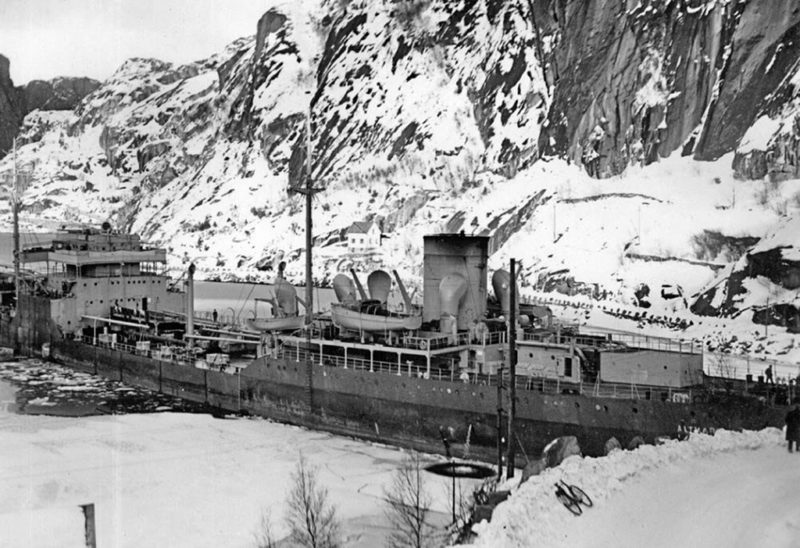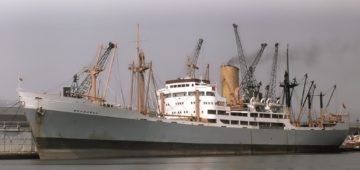The survival of Great Britain during WW2, and the then known British Empire did, as we all know focus around being able to import sufficient food, commodities, ammunition, and other war materials during the period of conflict. The attempts to prevent freedom of navigation for Allied ships has been well documented, especially regarding the attempted U-Boat blockade by the Axis powers.
However, far too often has the crucial role played by the Norwegian Merchant Marine during WW2 been somewhat downplayed, albeit not intentionally, with most of the credit going to the British, American and to a slightly lesser extent the British Commonwealth nations such as Canada, Australia, and New Zealand. Our Norwegian friends however, played a vital role in supplying Britain and other Allied zones of hostility with essential supplies, without which, the outcome of the conflict may have been very different.
More than 10,000 Norwegians, 9,379 men and 883 women, died as a direct result of the war. Only one- fifth of this number were derived from the Norwegian military. The highest single group of casualties among Norwegians came from their seafarers in their Merchant Navy. At sea, more than 3,600 civilians lost their lives, including 70 women. Consequently, seafarers made up more than a third of all the Norwegian war deaths. Their sacrifice was extremely important for the final determination of the war. This fact is often overlooked in the main mix of things and the Allies owe a real debt of gratitude for the sacrifices made by so many Norwegian sailors.
Of no less importance to the Norwegian campaign, was the sterling service provided by the Shetland Bus, a clandestine marine organization operated by the Norwegian fishing fleets and fisherfolk.
Norway’s policy of remaining neutral came to a prompt end on 9th April 1940, when Hitler’s Nazi Germany invaded the country, but the Norwegian Merchant fleet, the majority of which was at sea, in neutral or Allied waters, and ports, remained outside German limits of influence and control. Instead, the ships were requisitioned by the Norwegian government, and Nortraship was set up. This was the Norwegian Shipping and Trade Mission, based in London to administer the free Norwegian merchant fleet not under German control, which was frequently referred to as the world’s largest shipping company. The administration of the Nortraship establishment was undertaken by Senior Norwegian Shipping Managers, as well as British and American staffers.
The day-to-day operation of Nortraship was complicated and faced numerous challenges. The lines of command were difficult due to bilateral communication problems. On the one hand, information was vital to operate the fleet efficiently, whilst on the other hand, it was crucial that information did not leak out or fall into enemy hands. The final solution to this dilemma eventually became a wide network of Nortraship branches.
By the beginning of 1944 the Nortraship organization in London consisted of 17 individual departments, some divided into as many as five sections, whilst the New York office had 18 departments. Nortraship had 52 branch offices or representative offices, affiliated to either New York or London, located in 26 different countries.

Hence, the Norwegian Merchant Navy, their personnel, and ships played a vital role in the Allied fight against the Axis powers, but at a high cost. More than 700 ships were lost, and around 3,700 sailors lost their lives during the years of conflict.
The Norwegian seafarers and the fleet were pivotal during the Second World War, as part of the war effort, and as a source of funding for the Norwegian government in exile. Due to the mobility and global reach of Norway’s most important maritime sector, revenue could still be earned, even though the country was under occupation. The massive revenues earned from their ships that had been requisitioned, gave the Norwegian government in London resources that far exceeded what some other countries obtained.
The political situation under which the Norwegian crews rose to prominence was conspicuous. Although Norway was occupied by Nazi Germany, the sailors were working on behalf of Free Norway, aiding the Allied efforts at high risk to themselves. The Norwegian military had to rapidly give up their attempts at defending mainland Norway, but the ships and seafarers continued the fight. The transport of oil and petroleum products was particularly dangerous and difficult but significant to the Allied resistance and their ultimate victory.
The transportation of petroleum products formed the artery of the Allied fight for victory. In a frequently repeated quote, Winston Churchill claimed that Norwegian seafarers were worth more than a million soldiers. A substantial portion of the ships that were redirected by the Norwegian government were on their way to British ports at the time as there remained a robust relationship between Norwegian shipping and British trade. However, with the change in the conversion of the Norwegian fleet, from coal driven steamships to diesel driven motorships, it gave the Norwegian fleet more flexibility as it was no longer reliant of the coal supply from Britain as it had been in WW1. Moreover, a large share of the worldwide tanker fleet was Norwegian owned and operated, at around 40 per cent of the international tanker tonnage. This was a vital asset and would become particularly important for the provision of fuel for the British war effort. So, a UK at war, with an urgent need for sea transport to secure its survival, clearly summed up the situation at the time.
One prominent British politician, Philip Noel-Baker, commented after the war, “The first great defeat for Hitler was the battle of Britain. It was a turning point in history. If we had not had the Norwegian fleet of tankers on our side, we should not have had the aviation spirit to put our Hawker Hurricanes and our Spitfires into the sky. Without the Norwegian merchant fleet, Britain and the Allies would have lost the war”.
As a result of the limited military potential of the Norwegian naval defence and the strategic importance of the Norwegian coast, the British had already intervened and infringed upon Norwegian neutrality. In February 1940, British forces entered Norwegian waters and boarded the German vessel, Altmark (above), which was used to transport prisoners of war. Given that Norwegian inspections on three separate occasions had failed to discover around 300 prisoners that were secluded in the cargo hold of the ship, the British crosscheck and validation was therefore considered justified.

Subscribe today to read the full article!
Simply click below to subscribe and not only read the full article instantly, but gain unparalleled access to the specialist magazine for shipping enthusiasts.





Comments
Sorry, comments are closed for this item